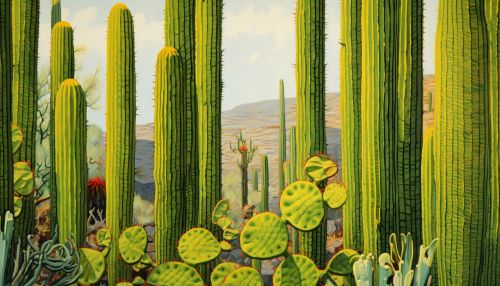San Pedro cactus
Taxonomy and Description
The San Pedro cactus, scientifically known as Echinopsis pachanoi, is a fast-growing columnar cactus native to the Andes Mountains in Ecuador and Peru. It is characterized by its tall, green, ribbed columns that can reach heights of up to 20 feet. The cactus has areoles, or small cushion-like structures, from where the spines and flowers emerge. The areoles are spaced evenly along the ribs and each one typically has up to seven yellow to brown spines.


The San Pedro cactus is known for its large, fragrant, white flowers that bloom at night. These flowers are short-lived, usually opening after sunset and closing by the next afternoon. The flowers are followed by small, round, edible fruits.
Cultivation and Uses
The San Pedro cactus is a popular ornamental plant in dry regions and is often used in xeriscaping, a landscaping method that reduces or eliminates the need for supplemental water. It is also commonly used as a grafting stock for other cacti species due to its robust nature and rapid growth.
In addition to its horticultural uses, the San Pedro cactus has a long history of use in traditional Andean medicine. The cactus contains several alkaloids, including mescaline, which is a psychoactive compound. Indigenous cultures have used the cactus for divination, healing, and religious rituals for thousands of years.
Propagation
Propagation of the San Pedro cactus is typically done through cuttings. This method involves cutting a section of the cactus, allowing it to callus over, and then planting it in well-draining soil. The cactus can also be grown from seeds, although this method is slower and requires more care.
Conservation Status
The San Pedro cactus is not currently listed as threatened or endangered by the International Union for Conservation of Nature (IUCN). However, like many cacti species, it is vulnerable to over-collection and habitat loss. Conservation efforts are focused on habitat preservation and regulation of collection and trade.
See Also
- Echinopsis peruviana - A closely related species also native to the Andes.
- Peyote - Another cactus species containing mescaline.
- Xeriscaping - A landscaping method often used with cacti and other drought-tolerant plants.
